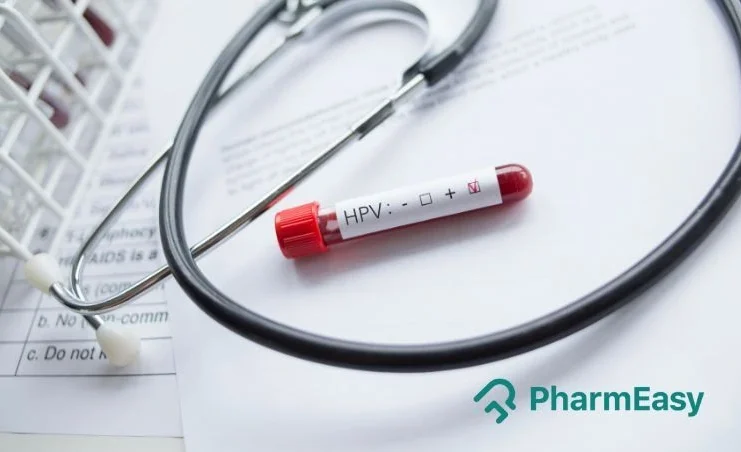Human Papillomavirus (HPV): What Is It, Causes, Symptoms, and Prevention
By Dr. Vishesh Bharucha +2 more

Get,

to manage your symptom
Get your,


4 Cr+ families
benefitted

OTP sent to 9988776655



You’ve successfully subscribed to receive
doctor-approved tips on
Whatsapp

Get ready to feel your best.

Hi There,
Download the PharmEasy App now!!


Register to Avail the Offer
Send OTPBy continuing, you agree with our Privacy Policy and Terms and Conditions

Hi There,
Sign up on PharmEasy now!!
Trusted by 4 crore+ families

OTP sent to 9988776655



You have unlocked 25% off on medicines




Code: NU25
By Dr. Vishesh Bharucha +2 more
Table of Contents
Human papillomavirus (HPV) is one of the most common sexually transmitted infections (STIs) prevalent globally. This virus primarily affects the skin and mucous membranes of the genital area, mouth, and throat, causing asymptomatic infections or growths called as warts. While most HPV infections resolve on their own without medical intervention, persistent infection with certain high-risk strains can lead to serious health issues, including certain cancers such as cervical, oropharyngeal (tonsils, base of tongue), anal, and penile cancers1,2.
In India, HPV-related cancers pose a significant public health challenge. Projections for 2025 estimate approximately 121,302 new HPV-related cancer cases, accounting for 7.7% of the total cancer burden in the country (3.3% among males and 12.0% among females).3 Therefore, understanding the causes, symptoms, and prevention methods for HPV infections is crucial for reducing the risk of diseases caused by this virus and promoting public health. In this article, we will discuss what is HPV, and why is it something we should all be aware of!

HPV belongs to a group of small, non-enveloped, double-stranded DNA viruses known as papillomaviruses. It mainly infects the basal cells of the skin or mucous membranes, usually entering through tiny cuts or tears on the surface3.
Once inside the basal layer of the skin (stratified squamous epithelium), the virus begins its life cycle. As the infected skin cells mature and move toward the surface, HPV replicates along with them.
In some cases (especially with high-risk types like HPV 16 and 18) the virus can interfere with normal cell functions. These high-risk types may integrate with the DNA of host cells, leading to the continuous production of proteins that block the body’s natural control over cell growth. Over time, this uncontrolled cell growth can lead to cancer, such as cervical cancer.
On the other hand, low-risk HPV types (like types 6 and 11) are not linked to cancer occurrence, though they can cause conditions like genital warts3.
Scientists have made major progress in understanding HPV, especially through genetic research, but there is still more to learn about how the virus behaves and changes over time4.
There are over 200 types of HPV viruses, and they are classified based on where they infect and the level of risk they pose. These types are broadly divided into:
These infect the skin rather than the mucosal (tissue lining of organs) areas5,6,7:
These infect the mucosal (tissue lining of organs) areas and are classified into two types:
Low-risk HPV types: These conditions are non-cancerous but can be recurrent or obstructive and may require ongoing medical treatment:5,6,7
High-risk HPV types: These types can cause pre-cancerous changes and cancers, especially5,6,7:
The HPV virus is mainly spread when a healthy person comes in direct contact with an infected person. Common human papillomavirus causes/modes of transmission include:
HPV is mostly transmitted sexually, in very few instances it is non-sexual for example when an infected person shares certain personal items ( like towel etc.). In such cases educating masses on maintaining personal hygiene is of paramount importance.
Dr. Nayana S Shetty, MBBS, MD
In most cases, human papillomavirus infection causes no symptoms and goes unnoticed, especially in the early stages. However, in some cases, HPV symptoms may appear due to warts or long-term complications of persistent infection:
Note: Vaginal or anal bleeding may occur in advanced cervical/anal disease; however, this is not an early or direct symptom of HPV itself.
HPV can lead to several serious health complications, particularly when caused by high-risk strains of the virus. While many human papillomavirus infections are asymptomatic and clear on their own, persistent infections can result in the following complications:
Since human papillomavirus infections are often asymptomatic, routine screening and specific diagnostic tests are essential, especially for women. While there is no general screening test for HPV in men, several tests can help identify HPV-related complications in both sexes. Common methods of HPV diagnosis include:
There is currently no cure for human papillomavirus infection itself, but various treatment options are available for HPV-related conditions, including genital warts and HPV-associated cancers.
Warts caused by HPV can be managed using various methods, depending on their location, size, and the patient’s immune response. However, it’s important to note that there is no antiviral cure to eliminate the HPV virus itself. Most HPV infections are cleared naturally by the immune system within 1 to 2 years. Treatment focuses on removing visible warts and relieving symptoms, not eradicating the virus. Common treatment options include2,4:
If HPV infection progresses to cancer (such as cervical, anal, vulvar, penile, or mouth cancer), management involves2:
Note: HPV-positive cancers, especially oropharyngeal cancers, generally have a better prognosis and may respond differently to therapy, which can influence treatment planning.

While HPV is a quite common virus, several steps can significantly reduce the risk of infection and its complications. These measures include:
The HPV vaccine is the most effective way to avoid infection from the most harmful types of HPV virus, including those that cause genital warts and cancer. It is ideally given before the onset of sexual activity, typically recommended for children aged 9 to 14, with a 2-dose schedule. Older individuals (aged 27 to 45) may also benefit from vaccination based on risk factors and in consultation with their doctor11.
HPV vaccine should be taken by all boys as well as girls. Talk to your doctor about the right age to take vaccine for your daughter/sister/ wife.
Dr. Nayana S Shetty, MBBS, MD
Using condoms and protection during vaginal, anal, and oral sex also helps to reduce the risk of HPV transmission1. Additionally, limiting the number of sexual partners can also decrease the risk of exposure.
Routine cervical cancer screening is recommended for women aged 21 to 65 years. This includes a Pap test every 3 years, or for women aged 30 and above, a combination of Pap test plus HPV co-testing every 5 years12. These screenings help detect early abnormal cell changes caused by HPV, allowing for timely intervention and prevention of cervical cancer.
Increasing awareness about HPV transmission, symptoms, and prevention methods helps reduce stigma and encourages initiative-taking healthcare. Parents should also be informed about the benefits of HPV vaccination for their children.
Also Read: HPV in Men: What It Is, Causes, Symptoms & Treatment
Although many HPV infections clear on their own without causing symptoms, it’s important to seek medical attention if you:
Also Read: HPV in Women: Causes, Symptoms, and Treatment Options
Human papillomavirus causes an cause warts and serious cancers, but most infections have no symptoms and clear on their own. Therefore, understanding what HPV is, what are the common HPV symptoms, and how to protect yourself through vaccination, testing, and awareness, are key to preserving long-term health and reducing the risk of serious complications.
Vaccines protect against the high-risk cancer-causing types (like HPV 16 and 18) and some low-risk types that cause warts (like 6 and 11), but they do not treat existing infections. Additionally, regular testing helps detect early changes caused by HPV for timely treatment. Together, vaccination, testing, and awareness are key to reducing HPV-related health problems and protecting public health.
Also Read: HPV Vaccine: What is It, When to Be Taken, Importance & Side Effects
It can take several years, often 15 to 20 years, for a persistent HPV infection to develop into cancer1.
Several factors can increase the risk of HPV infection, including early age at first sexual intercourse, having multiple sexual partners, smoking, long-term use of oral contraceptives (over 5 years), chewing betel nut, and exposure to radiation or ultraviolet (UV) light4.
There is no cure for the virus itself, but most infections clear naturally. Treatments are available for warts and precancerous changes2.
HPV is unique because many infections cause no symptoms and clear on their own, but some types can lead to cancer, unlike many other STIs1.
Disclaimer: The information provided here is for educational/awareness purposes only and is not intended to be a substitute for medical treatment by a healthcare professional and should not be relied upon to diagnose or treat any medical condition. The reader should consult a registered medical practitioner to determine the appropriateness of the information and before consuming any medication. PharmEasy does not provide any guarantee or warranty (express or implied) regarding the accuracy, adequacy, completeness, legality, reliability or usefulness of the information; and disclaims any liability arising thereof.
Comments

Leave your comment...
You may also like
Comments